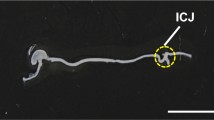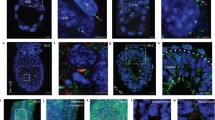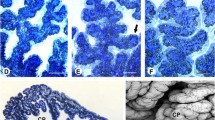Abstract
In human embryos and fetuses with a gestation age of 10.3 to 22 weeks, differentiation of the ciliary muscle was examined both by light and transmission electron microscopy. The smooth muscle cells develop from mesenchymal elements or early fibroblasts located in the region between the anterior scleral condensation and the ciliary pigment epithelium. The first musclelike cells exhibiting myofilaments and dense bodies could be distinguished during week 12. Smooth muscle cells with an adultlike appearance become apparent during week 15/16. Up to week 22, a cellular maturation process can be observed. Fibroblasts separating the muscle cell layers from each other also derive from the same precursor cells, as do the smooth muscle cells, thereby pointing to the close relationship between the two cell types.
Similar content being viewed by others
References
Chan AS, Balis JV, Conen PE (1965) Maturation of smooth muscle cells in the developing human aorta. Anat Rec 151:334a
Duke-Elder S, Cook CH (1963) Normal and abnormal development. In: Duke-Elder S (ed) System of ophthalmology, vol 3, part 1. Embryology. Mosby, St. Louis
Fuchs E (1928) Über den Ciliarmuskel. Graefe's Arch Clin Exp Ophthalmol 120: 735–741
Gabbiani G, Majno G, Ryan GB (1973) The fibroblast as a contractile cell: the myo-fibroblast. In: Kulonen E, Pikkarainen J (eds) Biology of fibroblast. Academic Press, London New York, pp 139–154
Herzog H (1902) Über die Entwicklung der Binnenmuskulatur des Auges. Arch Mikrosk Anat 60:517–586
Hogan MJ, Alvarado JA, Wedell JE (1971) Histology of the human eye. Saunders, Philadelphia
Ishikawa T (1962) Fine structure of the human ciliary muscle. Invest Ophthalmol 1: 587–608
Kelemen E, Janossa M, Calvo W, Fliedner TM (1984) Developmental age estimated by bone-length measurement in human fetuses. Anat Rec 209:547–542
Konishi I, Fujii S, Okamura H, Mori T (1984) Development of smooth muscle in the human fetal uterus: an ultrastructural study. J Anat 139:239–252
Krapp J (1962) Elektronenmikroskopische Untersuchungen über die Innervation von Iris und Corpus ciliare der Hauskatze unter besonderer Berücksichtigung der Muskulatur. Z Mikrosk Anat Forsch 68: 418–447
Mann I (1964) The development of the human eye, 3rd edn. Grune & Stratton, New York
Maunsbach AB (1966) The influence of different fixatives and fixation methods on the ultrastructure of rat kidney proximal tubule cells. I. Comparison of different perfusion fixation methods and of glutaraldehyde, formaldehyde and osmium tetroxide fixatives. J Ultrastruct Res 15:242–282
Remé C, Lalive d'Epinay S (1981) Periods of development of the normal human chamber angle. Doc Ophthalmol 51:241–268
Rohen JW (1952) Der Ziliarkörper als funktionelles System. Morphol Jahrb 92: 415–440
Rohen JW (1977) Morphologie und Embryologie des Sehorgans. In: François J (ed) Augenheilkunde in Klinik und Praxis, vol 1. Thieme, Stuttgart, pp 1.1–1.57
Ruprecht KW, Wulle KG (1973) Licht- und elektronenmikroskopische Untersuchungen zur Entwicklung des menschlichen Musculus sphincter pupillae. Graefe's Arch Clin Exp Ophthalmol 186:117–130
Seefelder R, Wolfrum C (1906) Zur Entwicklung der vorderen Kammer und des Kammerwinkels beim Menschen, nebst Bemerkungen über ihre Entstehung bei Tieren. Graefe's Arch Clin Exp Ophthalmol 63:430–451
Shiose Y (1961) Electron microscopic studies on the ciliary muscle. Acta Soc Ophthalmol Jpn 65:1267–1283
Stieve R (1949) Über den Bau des menschlichen Ziliarmuskels, seine physiologischen Veränderungen während des Lebens und seine Bedeutung für die Akkommodation. Z Mikrosk Anat Forsch 55:3–88
Streeten BW (1982) Ciliary body. In: Jakobiec FA (ed) Ocular anatomy, embryology, and teratology. Harper & Row, Philadelphia, pp 303–330
Uga S (1968) Electron microscopy of the ciliary muscle. Part II. On the fine structure of the anterior terminal portion of the ciliary muscle. Acta Soc Ophthalmol Jpn 72:1019–1025
Zypen E van der (1967) Licht- und elektronenmikroskopische Untersuchungen über den Bau und die Innervation des Ciliarmuskels bei Mensch und Affe (Cercopithecus aethiops). Graefe's Arch Clin Exp Ophthalmol 174:143–168
Zypen E van der (1970) Licht- und elektronenmikroskopische Untersuchungen über die Altersveränderungen am M. ciliaris im menschlichen Auge. Graefe's Arch Clin Exp Ophthalmol 179: 332–357
Author information
Authors and Affiliations
Additional information
This study was performed under the support of a training grant in ophthalmic electron microscopy from Deutsche Forschungsgemeinschaft
Rights and permissions
About this article
Cite this article
Sellheyer, K., Spitznas, M. Differentiation of the ciliary muscle in the human embryo and fetus. Graefe's Arch Clin Exp Ophthalmol 226, 281–287 (1988). https://doi.org/10.1007/BF02181197
Received:
Accepted:
Issue Date:
DOI: https://doi.org/10.1007/BF02181197




